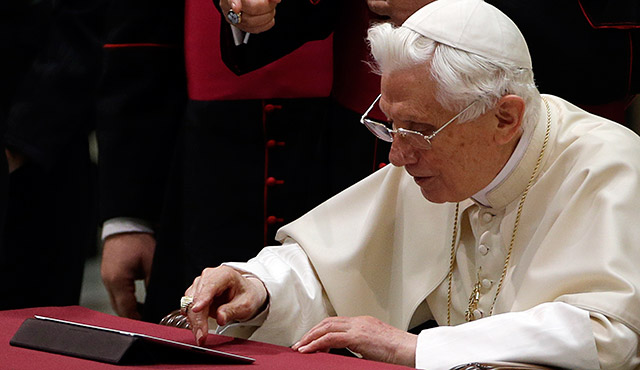At their church’s annual gala fundraiser at the City National Grove of Anaheim on Feb. 11, parishioners of Holy Family Cathedral in Orange had, for the first time, a new option of bidding during the silent auction:
A smart phone app.
Some of the older parishioners with mobile phones needed help.
The youngsters at the gala — teens and pre-teens — walked up to help them.
“They told them, ‘You go here; this is how you do it,’” recalled Father Troy Schneider, parochial vicar of HFC. “For the first time in a while, I saw younger parishioners talking to older ones. It was a real sense of community.”
For Father Troy, the scene at the gala was a perfect example of how his church has embraced technology and used it for good.
And although Father Troy and others believe the Diocese of Orange and the Catholic Church as a whole may have, at times, been slow to keep up with dizzying advances in technology, the sense is that is changing — although some veteran priests still cling to the old ways of running parishes.
Father Troy pulls up his calendar on his computer in his office.
He says that of the 12 HFC staff members who could digitally access his calendar to instantly access his schedule, fewer than five have opted to do so, with the rest relaying on emails, the telephone, texts and less efficient ways to stay on top of his appointments.
One of those colleagues with access to his electronic computer was able to quickly schedule Father Troy to cover a funeral for HFC rector the Rev. Msgr. Douglas Cook, who suddenly had to leave town after a death in the family.
“We have to change,” Father Troy says of technology, “otherwise we fall too far behind.”
He notes that parishes increasingly have become more challenged as congregations have grown and pastors have taken on more administrative responsibilities.
“The old methods of communication are not as efficient anymore,” says Father Troy, pointing out on his desk a “While You Were Out” message, which in today’s digital age looked shockingly archaic.
Holy Family Cathedral and the Diocese of Orange recently have taken steps to become more technologically minded, for the same purpose that goes back centuries at the dawn of the church: spreading the Gospel.
“Ultimately, that’s what we do,” Father Troy said. “I see a movement toward more of that administrative responsibility being placed on lay people so priests can focus on the sacramental ministry, which is their primary role.”
Father Troy spoke of the era of Paul the Apostle, who journeyed by foot and by boat all around Mesopotamia and Rome in the 30s to the mid-50s AD.
“Paul was not able to do what he did without the help of the roads,” said Father Troy, who used to work in the machine tool industry for Boeing before he entered the seminary in 2004.
“In order for us to spread the Gospel, we need to use today’s roads, and today’s roads are the Internet and technology — and we can’t be afraid of that.”
Holy Family Cathedral soon will launch a “Monday Morning Monsignor” feature on its website, hfcathedral.org. The Rev. Msgr. Cook will provide each week a sort of state of the union of the parish in a two-minute recorded message for parishioners to view at their convenience.
Also set to roll out soon at HFC is “Ask The Vicar,” in which a parish family will be featured and Father Troy will respond to their question.
“It’s all about being interactive and connecting with the parish community,” he said of technology.
The bigger picture
What about the bigger picture, of the Catholic Church throughout the centuries, when it comes to technology?
Contrary to the perception that the church, as a whole, has suffered from institutional sclerosis when in comes to keeping up with technology, one leading scholar argues otherwise — that throughout its history, the Catholic Church has served as a lab, of sorts, for the advancement of science.
“The church has to know its culture in order for her to be able to evangelize,” said Pia de Solenni, professor of moral theology at the Augustine Institute. “As Saint John Paul II put it, the church needs to be in the world, but not of it.”
Technology obviously can be used inappropriately, de Solenni and Father Troy noted. But the church should embrace its many benefits, they said.
“As we advance in technology,” Father Troy said, “it all depends on the intent technology is used for. For the church, the question is, is it used for spreading the gospel and keeping us connected?”
Pope Francis and, before him, Pope Benedict, opened Twitter accounts to achieve just that — something Father Troy and de Solenni applaud.
“The use of any technology, the use of communication,” Father Troy said, “is all about connecting. It’s about communicating and getting the Word out.”

